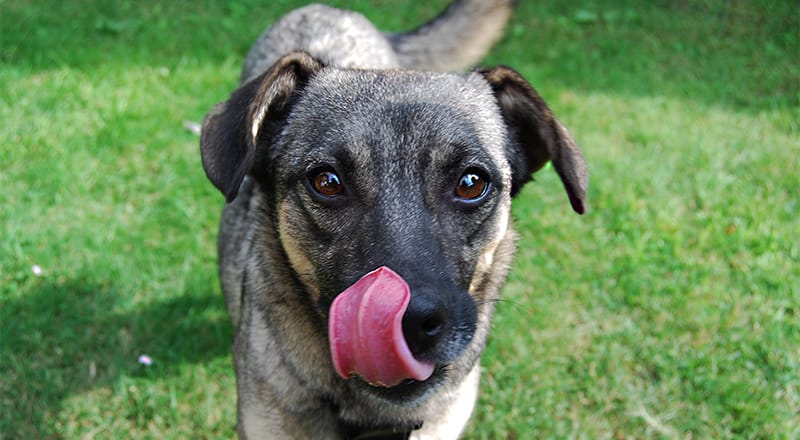How to Get Your Dog to Stop Licking You
Published: Last updated: by Jessi Larson Affiliate Disclosure: We hope you love the products we've recommended! As an Amazon Associate we earn a small share from qualifying purchases.Most people don’t mind a few puppy kisses, but when it turns into a full-out bath, it sure can get annoying.
For the most part, my dog Toby doesn’t lick too much. He does, however, go on spells where he just can’t stop. Sometimes, it’s because I just worked out, and he likes to lick the salty sweat off my skin. Other times, I’m just not sure what the heck is going through his mind. Case in point: Last night, when I was trying to fall asleep, he sat on my bed and licked my face every time I started to doze off.
If your dog loves to lick a little too much, either all the time or just on occasion, we’ve got some suggestions for how to curb this unwanted behavior.

Why do dogs lick?
Before we figure out how to fix the problem, let’s first get to the root of the issue. Why do dogs lick in the first place?
From the get-go, dogs are taught to communicate through licking by their mother, who uses this action to help her pups start breathing. She also licks her young to give them a bath and show them affection. So it’s an ingrained instinct.
For dogs, licking is a way to show affection and feel happy. According to Animal Planet, the process of licking releases pleasurable endorphins, which decrease stress and make dogs feel doggone good.
They also lick because they like the taste of your skin, like, for example, as I mentioned before, the sweat or oils that you emit. (Lovely!)
How do you make it stop?
We can all agree that licking is totally natural (unless your dog is compulsive and can’t stop – more on that later), but how do you get your dog to stop when it goes too far?
1. Ignore your dog
When you think about it, dogs often lick because they get attention. They come up and give you a kiss, so you pet them. (Or, in my case, kiss back. Don’t judge.) Without realizing it, however, you’re rewarding and even encouraging this behavior.
If you really want your dog to stop, try ignoring them. Don’t give them the affirmations they need. If your pup doesn’t receive any attention, chances are they’ll cut it out.
2. Say no and walk away
If simply ignoring them is too weak, take it one step further and say “No!” in a firm voice when they lick and pull away. This will signal that you don’t like this behavior and consider it to be bad.
3. Put something in their mouth
Dogs sometimes lick simply because they want something to do. You can redirect that energy, however, by giving them something to put in their mouth, like a KONG with peanut butter, a bone, or a chew toy. They’ll be too busy to bother licking you after this.
If your dog’s licking extends to other people, which is even more obnoxious, this tactic is a great diversion that works quickly!
4. Get some exercise
As I mentioned before, dogs are sometimes just looking for something to do. They may just have a lot of pent-up energy they need to burn off.
If your dog won’t stop licking, it may be a wise idea to evaluate how much exercise they’re getting. It may not be enough. To tell, take your dog for a walk or a trip to the dog park and see if it subsides.
5. Add bitters
This might just be the most drastic of the suggestions, but it is effective. If you’ve got an obsessive licker, it may be time to break out the bitter spray. Totally safe and non-toxic, the bitter spray tastes yucky to dogs and discourages licking. Just spray a bit on the skin your dog is licking, and they’ll quickly be dissuaded.
We bought Grannick’s Bitter Apple Spray when Toby was a puppy and couldn’t stop licking and biting our furniture, and it worked wonders.
What if there is a bigger issue?
Although rare, if you’ve tried all these options and your dog is still constantly licking, there may be a bigger issue at hand. A pup that doesn’t stop may have gastric reflux, allergies, severe anxiety, or other ailments. A veterinary exam can help determine if there are health problems contributing to the problem. It’s probably nothing, but always better to be safe than sorry.




 Getting a New Dog?
Getting a New Dog?